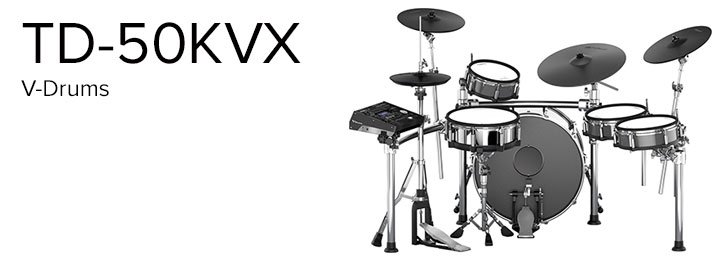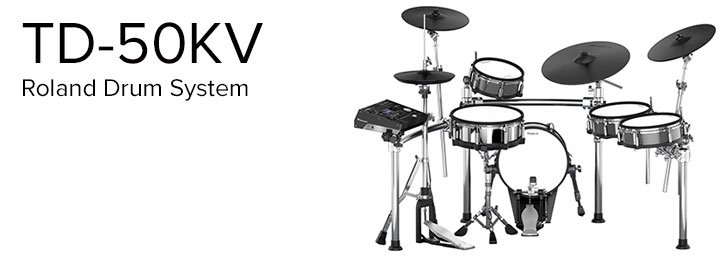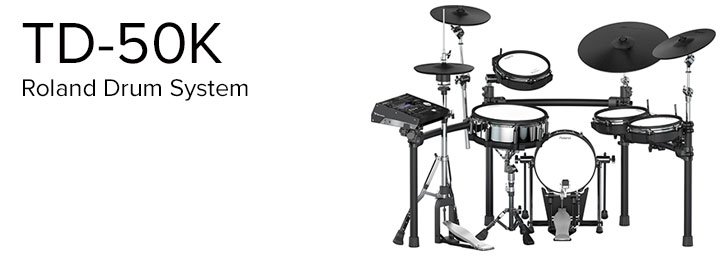Kicks and snares are obviously crucial to drumming, but your tom sounds are what really tie your kit together.
Here, we’ll cover how to enhance your TD-50 tom sounds.
From thunderous rolls to subtle builds, complex flourishes and fills or straightforward accents, tom sounds help to extend the playability of your kit for endless variations.
So it’s important that they sound good!
Tom sounds and even physical depths go in and out of fashion quicker than snare and kick depths, so it’s a good thing that you can adjust them on the TD-50 to suit your sound.
Many drummers choose tom depths based on how easy they are to position in their kit or by how cool they look, but in the studio where the sound is everything, anything goes.
There are many tricks used for toms, from mic positioning to head type, muffling and head tension, not to mention post-production.
Techniques such as transient shaping, EQ, compression and reverb effects can be used for enhancing the TD-50 tom sounds.
All of these aspects and more can be modified inside the TD-50 for the ultimate tom sound. See the following drummer’s guide to the TD-50.
Contributed by Simon Ayton for Roland Corporation Australia
1. Change the Shell Depth
Jazz tom sizes tend to be shallower, whereas classic rock tom sizes are squarer.
Square sizes are when the depth tends to follow the diameter. So, a 10” tom would also have a 10” depth. A 16” floor tom would have a 16” depth and so on.
Deeper toms mean more sustain and a lower pitch than shallower drums.
[INSTRUMENT] | [PAGE DOWN X2] | F4 (TRANSIENT ON) | R1 (Time) | R2 (Attack) | R3 (Release)
Try: Squarer sizes – 10” depth for a 10” tom, etc.
2. Change the Head Type
Coated heads tend to be used for a classic, rounder tom sound, due to the coating providing a natural muffling effect.
A pinstripe or clear head will give more attack and also increase brightness, without the need for adding EQ.
There are no rules and there are many classic rock albums made with coated heads, so it’s up to you to decide what works best for the song and your playing.
[INSTRUMENT] | F1 (INST) | R3 (Head Type) | Clear-Pinstripe
Clear | Bright and resonant.
Coated | Darker attack and more controlled overtones.
Pinstripe | Aggressive attack with exaggerated Mid-EQ and controlled sustain.
Try: Clear.
3. Change the Tuning
Toms are often tuned in equal intervals but again, it’s a personal thing.
You may want to tune your first tom to the highest note in the song, tune it so that it pops out of the mix or simply tune it for the best sound, regardless of the pitch.
[INSTRUMENT] | F2 (BASIC 1) | R1 (Tuning) | -100-+100
Try: Slightly detuned toms.
4. Change the Sustain and Remove Snare Buzz From The Toms
Muffling tom sounds will help control the sustain of the drums making toms sound deeper too.
A technique you can use when adjusting this is to start with it Off.
Once you have a drum groove recorded, gradually increase the muffling of the toms, so that the sustain doesn’t overlap when you’re playing down the toms in a typical fill.
This will help the toms to cut through the mix and give them definition. Be careful though, too much muffling can affect the flow of the performance and make the toms sound unnatural.
Just the right amount can help increase the warmth and clarity of the toms in the mix. No duct tape needed!
Snare buzz is a common problem when recording toms in a kit setup, due to their proximity to the snare drum.
Some engineers even remove the toms from the recording room altogether and record them as an overdub after the main drum take is done, in order to achieve the cleanest drum sounds.
Removing buzz helps to achieve a cleaner, fatter sound from the toms, but the drawback is that they can sound unnatural if not carefully tuned and played.
Snare buzz and muffling can be adjusted at any time in the TD-50.
[INSTRUMENT] | F2 (BASIC 1) | R2 (Muffling) | OFF-FELT4
OFF | Full ring/sustain and overtones.
TAPE2 | Controlled ring and moderate tonal change.
FELT4 | Maximum tonal change and minimum ring and sustain.
Try: Muffling OFF and gradually increase.
[INSTRUMENT] | F2 (BASIC 2) | R3 (Snare Buzz) | OFF-8
Try: OFF
5. Move the Microphone Position
Engineers spend a lot of time finding the best microphone positions for toms, in order to capture the maximum power, attack and resonance.
The TD-50 offers the ability to move the virtual microphone position for every acoustic sound in the module.
Moving a microphone further towards the centre of the tom increases attack and also the body of the sound.
[INSTRUMENT] | [PAGE DOWN] | F1 (MIC POS) | R2 (Mic Position) | OUTSIDE4-INSIDE4
OUTSIDE4 | Open, less resonant, bright, distant.
INSIDE2 | Blend of resonance with more body, tone and stick attack.
INSIDE4 | More resonance and obvious note, punchy, maximum stick attack.
Try: INSIDE3.
6. Change the Bottom Head Tension
With an acoustic tom, changing the tension of the bottom or “resonant” drum head also affects the pitch of the tom sustain, making the note bend up or down.
You can do this with any sound in the TD-50 using the Pitch Sweep parameter.
At a setting of zero, the pitch of the sound will sustain evenly.
Raising the Pitch Sweep value raises the initial pitch of the attack, with the tail of the sound bending down to the original pitch. Lowering the value has the opposite effect, bending the note up.
The Pitch parameter of the TD-50 allows the initial pitch to be corrected up or down.
[INSTRUMENT] | F4 (ADVANCED) | Pitch (-4800-+4800) | Pitch Sweep (-100-+100)
Try: Pitch Sweep 3.
7. Modify the Attack and Sustain of Tom Sounds
The Transient page in the TD-50 is the perfect place to go for modifying the attack and sustain characteristics of sounds, without having to use muffling, gates or compressors.
Three simple controls let you quickly modify your tom sounds to suit any situation.
If the toms are not cutting through in the mix, simply increase the attack. If you want the toms to sound fuller with more body and sustain, decrease the attack and increase the release.
You can also adjust the timeframe and the overall volume of the affected sound resulting in sounds that sit well in the mix.
[INSTRUMENT] | [PAGE DOWN X2 | TRANSIENT | R1 (TIME) | R2 (ATTACK) | R3 (RELEASE)
Try: Time 10 / Attack -66 / Release 65.
Recommended Article: How To Enhance A Roland TD-50 V-Drums Snare Sounds








